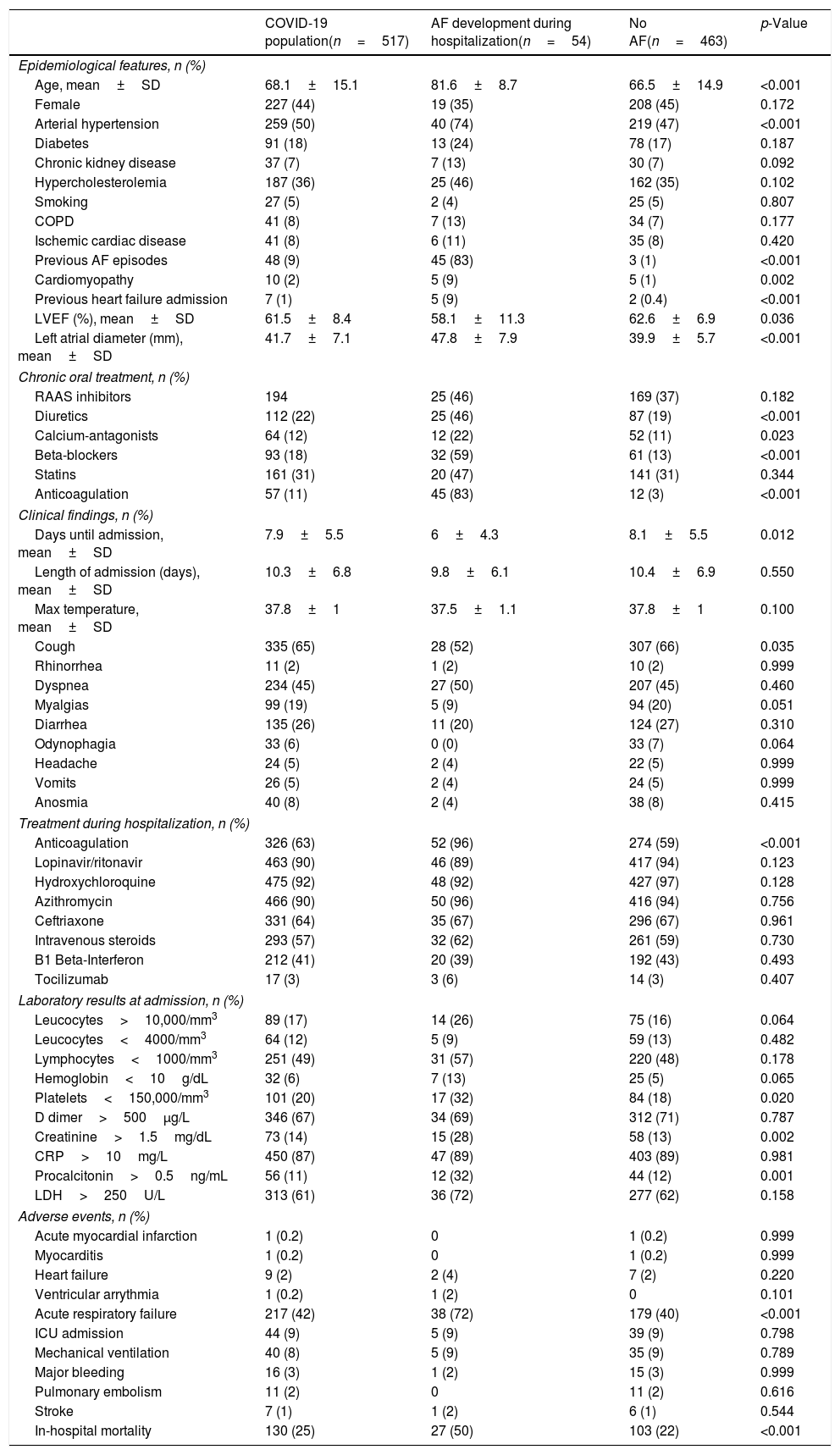the SARS-CoV-2 infection ranges from asymptomatic to critical forms and several prognostic factors have been described. Atrial fibrillation (AF) is common in acute situations where it is linked with more complications and mortality. We aimed to evaluate the prognostic information of AF in this population.
Methodsretrospective analysis of a cohort of 517 patients consecutively admitted in a tertiary hospital due to SARS-CoV-2 infection. We divided the patients in two groups according the development of AF and compared the main features of both groups. An univariable and multivariable analysis of mortality were also performed.
Resultsamong 517 patients with SARS-CoV-2 infection admitted in a tertiary center, 54 (10.4%) developed AF. These patients are older (81.6 vs 66.5 years old, p<0.001) and present more hypertension (74% vs 47%, p<0.001), cardiomyopathy (9% vs 1%, p=0.002), previous heart failure admission (9% vs 0.4%, p<0.001), previous episodes of AF (83% vs 1%, p<0.001) and bigger left atrium (47.8 vs 39.9mm, p<0.001). AF COVID-19 patients present more acute respiratory failure (72% vs 40%, p<0.001) and higher in-hospital mortality (50% vs 22%, p<0.001). Predictors of AF development are age and previous AF. AF is not an independent predictor of in-hospital mortality. Predictors are age, creatinine>1.5mg/dL at admission, LDH>250UI/L at admission and acute respiratory failure.
ConclusionAtrial fibrillation appears in 10% of hospitalized patients with SARS-CoV-2 infection. These patients present more comorbidities and two-fold increase in hospital mortality. Atrial fibrillation is not an independent prognostic factor.
La infección por SARS-CoV-2 presenta un amplio espectro clínico, y varios factores pronósticos han sido descritos. La fibrilación auricular (FA) es frecuente en situaciones agudas, donde se ha relacionado con aumento de complicaciones y mortalidad. Nuestro objetivo ha sido evaluar el impacto pronóstico de la FA en esta población.
MétodosAnálisis retrospectivo de una cohorte de 517 pacientes con infección SARS-CoV-2 consecutivamente ingresados en un hospital terciario. Dividimos a los pacientes en dos grupos de acuerdo al desarrollo de FA durante el ingreso y comparamos las características de los grupos. Realizamos análisis univariado y multivariado de mortalidad.
ResultadosDe los 517 pacientes, 54 (10,4%) desarrollaron FA. Estos pacientes son mayores (81,6 vs. 66,5 años, p<0,001) y presentan más hipertensión (74% vs. 47%, p<0,001), miocardiopatía (9% vs. 1%, p=0,002), ingreso previo por insuficiencia cardiaca (9% vs. 0,4%, p<0,001), historia de FA (83% vs. 1%, p<0,001) y mayor aurícula izquierda (47,8 vs. 39,9mm, p<0,001). Los pacientes con FA presentan más fallo respiratorio agudo (72% vs. 40%, p<0,001) y mayor mortalidad hospitalaria (50% vs. 22%, p<0,001). Los predictores de FA son la edad y la historia de FA previa. La FA no es un predictor independiente de mortalidad hospitalaria. Los predictores son: edad, creatinina >1,5mg/dL al ingreso, LDH>250U/L al ingreso y el fallo respiratorio agudo.
ConclusiónLa FA aparece en el 10% de los pacientes hospitalizados por SARS-CoV-2. Estos presentan mayor comorbilidad y el doble de mortalidad hospitalaria, pero la FA no es un factor pronóstico independiente.









